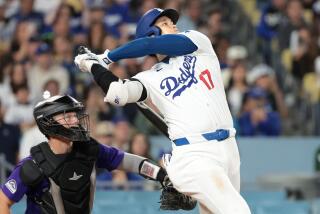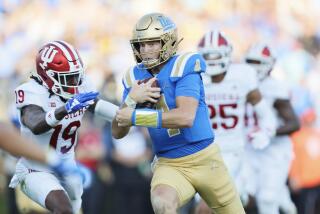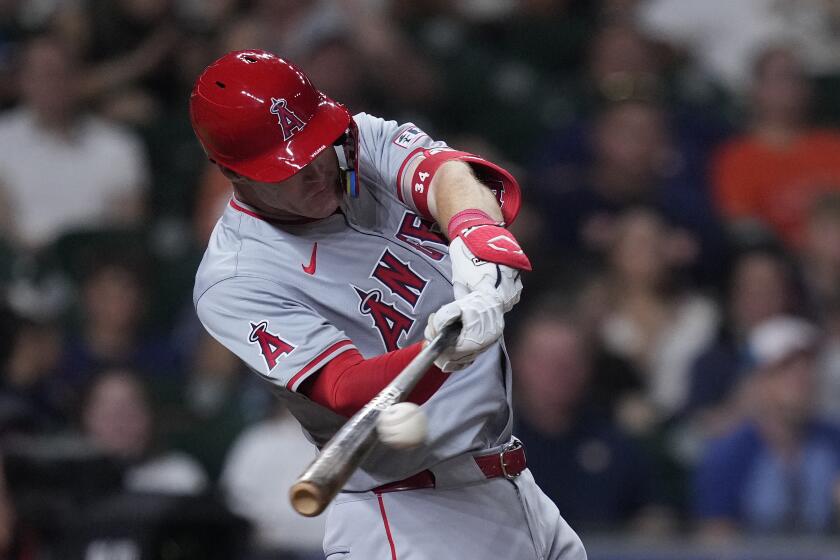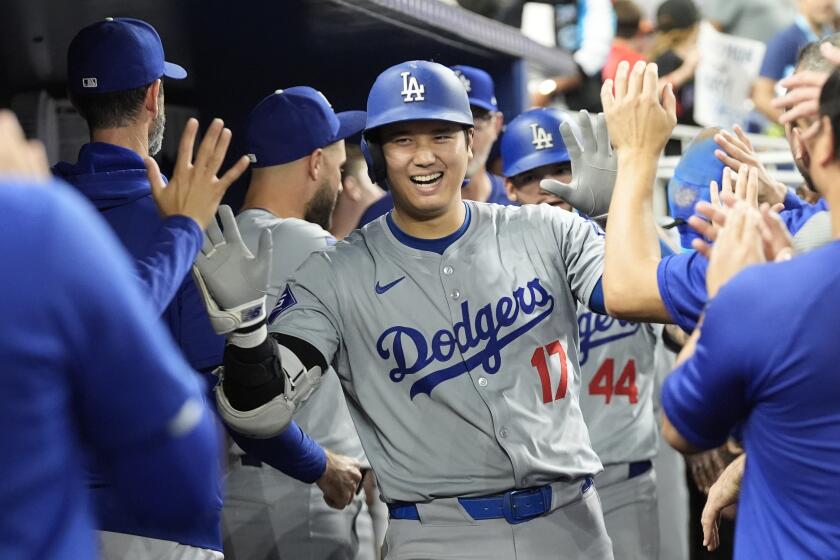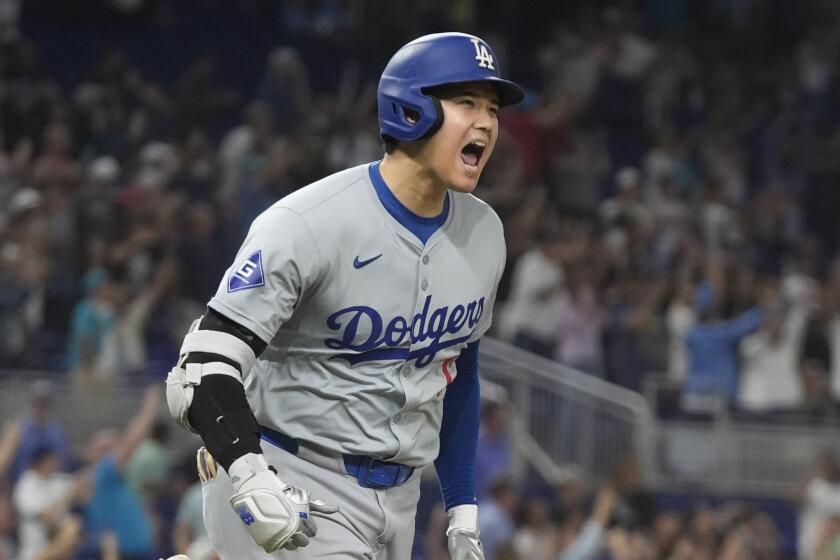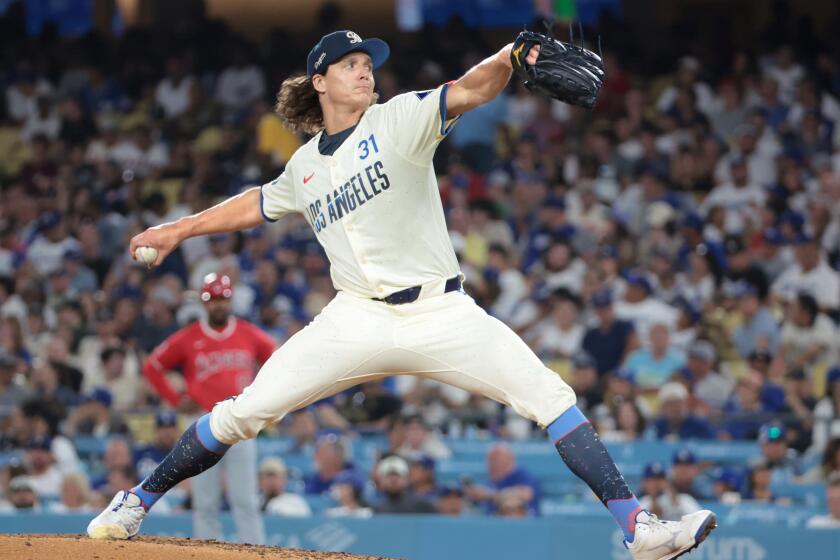Revved Up at the Ravine
After Chavez Ravine was razed and Dodger Stadium opened in 1962, the area became a lightning rod for organizers of many things other than baseball.
Pope John Paul said Mass there. The Beatles, Rolling Stones and Michael Jackson performed there. So did the Three Tenors. There have been basketball games, ski jumping, boxing and a political rally.
First, though, was motor racing. Almost as soon as the vast stadium parking lot -- large enough to accommodate 16,000 automobiles -- was paved, sports car enthusiasts from the California Sports Car Club sought it for a race.
If 40,000 or more spectators would travel out beyond Riverside to watch Roger Penske, Ken Miles, Lance Reventlow, Bob Bondurant and other nationally known drivers, Cal Club officers pondered over how many would show up to watch the same cast only a mile or so from City Hall.
A tight little course of 1.3 miles, with nine turns and tricky dips, was laid out on the outer and inner perimeter roads that circle the stadium. The start-finish line was out behind center field.
Promoters claimed it was “the first time a road race has been held smack in the middle of a major U.S. city.”
The first races were March 2-3, 1963, and the last ones 40 years ago this week (Dec. 14-15.)
The “Field of Dreams” mantra that “if you build it, they will come” did not hold. For reasons that still puzzle some old-timers, the races did not attract many spectators. Estimates ranged from “4,000 or less” by a magazine writer to 18,000 by the Cal Club president for the final weekend.
Miles, a veteran British endurance race driver who had settled in Hollywood, won all four modified main events in the Precision Motors’ Porsche Spyder, two in March and two in December. That, it turned out, was one of the problems of selling the event.
The course was too tight for the bigger, more powerful cars of the era, which were either forced to slow down or be battered by curbs, concrete pylons, light poles or other cars. Miles himself labeled it a “Ken Miles Spyder Course.”
In the hyped battle of production cars between the Ford Cobras and the new Chevrolet Sting Ray Corvettes, it was no contest as Carroll Shelby’s Ford-powered AC Cobras left the Chevies of Bondurant, Dick Guldstrand and Paul Reinhart chasing shadows.
With no straightaway, Miles’ average winning speed was 65 mph. Cars were going faster than that right next door on the Pasadena Freeway.
“All that power and no place to use it,” complained Dave MacDonald of El Monte, driver of one of Shelby’s Cobras -- and he was one of the winners. “Use it and lose it.”
MacDonald, who would lose his life the following year in the 1964 Indianapolis 500, won production-car races in March and finished second to Miles in the modifieds.
Miles was killed while testing a Ford J-car at Riverside on Aug. 17, 1966.
“Dodger Stadium wasn’t a good course for the big cars, but it was significant in a way because it was the first time the solid-axle Corvettes took on the Cobras,” said Guldstrand, who is still engineering custom Corvettes in Burbank. “It was the beginning of their head-to-head competition.”
Mufflers were rather primitive as far as race cars went 40 years ago and when the city’s Department of Building and Safety mandated their use, many enthusiasts felt cheated without the full-throated roar of the Porsches, Corvettes, Cobras and Maseratis at speed. Another sore point was that mufflers drained horsepower and slowed the cars.
The first race was originally scheduled for November 1962, but was delayed until the following March because of complaints by nearby residents about noise, pollution and traffic. The DBS conducted pre-race sound tests before giving permission for the races to be held.
It did not help, either, that neither Penske nor Reventlow showed up for the March opener. Penske had won the Times Grand Prix at Riverside in 1962 and Reventlow had developed the popular rear-engine Scarab. Both filed entries and were widely publicized in pre-race promotions, but on race day, both said their cars were not ready.
“It was not as good a spectator course as we anticipated,” recalled Davey Jordan of Running Springs, who finished third in a production race won by Formula One driver Ronnie Bucknum. “Like most street courses, you could only see a turn or two at a time, and it didn’t take long before everyone knew the big cars didn’t have much of a chance.”
With a course narrowed by three-foot white concrete pylons and numerous hay bales surrounding light standards, some races took on the character of a destruction derby.
Veteran driver Bob Kirby of San Marino spun into one of the light poles, breaking his Porsche in half and sending him to the hospital with broken ribs.
“The racing was sort of slow, but it was more dangerous than it looked because there wasn’t much room for the cars and a lot of them were banging on each other,” recalled Topper Chasse of Alhambra, who was a crewman on Kirby’s car. “It was pretty exciting to watch, though.”
Doug Hooper, who won a Saturday race in a Corvette, had his problems with the concrete cones.
“I won there on Saturday, then on Sunday I lost it and got the car impaled on one of those big cement things,” he was quoted in the book, “California Screamin’: The Glory Days of Corvette Racing.”
Jimmy Dittmore and his Triumph were not so fortunate. He flipped the TR-3 in the hay bales, but only the car was hurt.
Brian Tracy of La Verne, there as a spectator, said the racing was a “road course demolition derby. One weird thing was that the cones were cement, but they looked just like the plastic ones used at other races -- until you ran into one. They really ripped up some fenders.”
In his biweekly Motor Racing paper, editor Gus Vignolle reported that the organizers needed 25,000 in attendance to be successful. The first races were planned to familiarize audiences with sports car racing, but when the December races attracted little more than half that number, future races were doomed.
“The entry was small and lacked luster,” wrote J. G. Anthony, and that about told the story of motor racing’s experiment in the Dodger Stadium parking lot.
Deke Houlgate, publicist for the December race, said he felt the low turnout was partially caused by the Baldwin Hills dam tragedy.
“We had a big press turnout on Saturday with photogs from the local papers and cameramen from all the TV stations, but that was the day the Baldwin Hills dam broke and when it happened, they all took off,” Houlgate recalled. “So we had very little publicity for the Sunday race.”
It was also only a few weeks after President Kennedy had been assassinated on Nov. 22, and the country was still in shock.
Two Dodger Stadium races were on the 1964 Cal Club schedule but were never held. Nor have there been any since.
More to Read
Go beyond the scoreboard
Get the latest on L.A.'s teams in the daily Sports Report newsletter.
You may occasionally receive promotional content from the Los Angeles Times.
